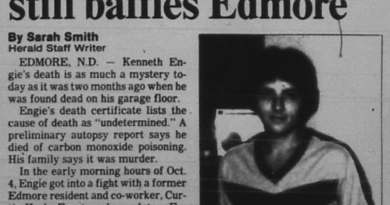Deanna Cremin Attacked, Assaulted and Murdered in Somerville Massachusetts
On March 29, 1995, Somerville, Massachusetts, moved through a typical midweek rhythm. Classes let out at the high school, homework and dinner plans filled the evening, and the quiet of a late March night settled over three deckers and narrow side streets. Somewhere inside those ordinary hours, a terrible act stole the future of a 17 year old student named Deanna J. Cremin. By the next morning, her murder would reshape a neighborhood’s sense of safety and begin a long search for answers that continues to this day.
Who Deanna was and why her life mattered
Deanna was a junior at Somerville High School, a daughter, a sister, and a friend whose life was knit into the texture of the city. Teachers remembered a respectful student who was quick with a smile. Friends remembered a teenager who babysat nearby children, joked easily, and moved comfortably between classmates from different corners of town. Family remembered a young woman stepping into adulthood with hopes that matched the size of her heart. It is important to begin with this portrait, because a case file can reduce a life to logistics. The full truth starts with a person who was loved and who loved in return, a person whose days mattered before they were counted and recorded.
What is known about the final evening
March 29, 1995, was a Wednesday. After school and into the evening, Deanna followed a routine that friends and family recognized. She spent time with people she knew well, the kind of midweek social time that sets up the next morning’s return to normal. Late that night, shortly before midnight, she began the short trip home. She never arrived. Sometime between that last familiar moment and the early morning light, she was attacked, sexually assaulted, and strangled. The specifics of those minutes are the guarded core of an open investigation, but the broad outline is clear. There was no long absence, no extended period unaccounted for by family. There was a short window in a small radius, and within it a crime that was both intimate and brutal.
When discovery ended doubt and began a homicide inquiry
At about 8:00 a.m. on March 30, 1995, the morning after her last known movements, two children Deanna had babysat discovered her body behind a senior housing complex off Jaques Street. The location is a short distance from her home, the kind of distance a teenager could cross in a handful of minutes. The discovery collapsed every hopeful explanation and set the trajectory for the investigation that followed. Somerville police, state investigators, and the Middlesex County District Attorney office converged on the scene. What had been a missing person concern hours earlier was now a homicide scene with a painfully narrow geography and a chilling set of facts.
Where the crime scene sits within the city map
The Jaques Street area is a dense piece of Somerville, a tangle of short blocks, fences, and cut throughs that local residents know well. The senior housing complex that borders the discovery site is the kind of place that keeps regular hours, with early walkers and neighbors who notice unusual movement. The very proximity to her home is among the most haunting features of the case. She was nearly home. The spot where her body was found is less than a block from the comfort and safety she expected. That short distance magnified the shock across the neighborhood, because it suggested that the violence did not require a remote hiding place to be carried out and concealed overnight.
How investigators framed the first days
In a case like this, the first days belong to forensics, to witness canvassing, and to timeline reconstruction. Investigators secured the scene, documented every recoverable trace, and began the difficult work of moving outward from the last known point. They interviewed family, friends, and people who saw or spoke to Deanna on March 29. They asked about footsteps and voices in the late evening. They gathered any memories of unfamiliar faces or vehicles near the complex and near Deanna route home. A composite sketch of a man seen in the vicinity circulated later, a white male in his early to mid forties, average height and build, a description broad enough to trigger memory but not so specific that it could end the case on its own.
What the community did and continues to do
Somerville responds to loss with presence. The days after Deanna death saw vigils, memorials, and quiet acts of solidarity. Families who knew her placed flowers and notes along the route she should have walked. The city marked anniversaries with moments of silence and with public statements that refused to let the case fade from view. Over the years a reward has been maintained and increased, with public figures citing $50,000 and later $70,000 as the amount available for information leading to an arrest and prosecution. The money matters, but the message matters more. It says to any person carrying a piece of the truth that the city will value the risk it takes to come forward.
Why the case remains stubborn
Some homicides resist immediate resolution even when they occur close to home. Nighttime compresses sightlines. A five minute walk can be empty of witnesses if the timing is unlucky. Intimate violence often leaves trace evidence, but the usefulness of that evidence depends on conditions that a killer does not control and on standards of collection that have evolved across decades. The mid 1990s were not the forensic desert of earlier eras, yet they were not the present either. Investigators have revisited preserved items as technologies improved, reexamined combinations of biological, fiber, and touch based evidence, and returned to earlier statements with new ways of testing consistency. Those efforts have produced leads and renewed hope, even as they have not yet produced a charge in court.
The discipline of sharing without compromising the record
Families and communities want details. Investigators need to protect some of those details to preserve the ability to test future statements. The balance is difficult. Public updates emphasize what can be said safely. Deanna was attacked, she was sexually assaulted, and she was strangled. She was found on March 30, 1995, behind a senior housing complex near Jaques Street, close to home. Those facts frame all public discussion. Other elements remain withheld so that when someone speaks with apparent knowledge, detectives can separate rumor from confession and proximity from participation.
What might finally break the case open
Cold cases close for two broad reasons. A person decides to tell the truth, or new technology extracts meaning from old material. In Deanna case, either path remains plausible. A witness who felt bullied or bound by loyalty in 1995 may no longer be within the same circle or under the same pressure. A person who once kept a secret to avoid the consequences of a peripheral role may be ready to admit what they saw. On the scientific side, modern approaches to low level DNA, mixture deconvolution, and genealogy powered identification have changed the landscape. A partial profile that once sat in a folder with a note that read inconclusive might now be separable from background and comparable against wider databases. A mixture that was once unreadable might now reduce to a set of individuals, one of whom aligns with a known associate or a person who lived or worked along Deanna route.
The human stakes of patience and persistence
Every year since 1995, Deanna family has carried the weight of unfinished business. Birthdays and holidays arrive with an empty space that never softens. The city has carried its portion of that weight too, in civic rituals that honor memory and in a public square that refuses to shift attention elsewhere. That persistence is not simply sentimental. It has practical effects. It ensures that the case file never settles into dust, that tips still find a place to land, and that anyone who knows something must live with the knowledge that their silence is noticed, not ignored.
Who, what, when, and where, set plainly
Who was the victim. Deanna J. Cremin, a 17 year old student, daughter, sister, and friend. What happened. She was sexually assaulted and strangled, and her body was left behind a senior housing complex. When did it occur. The night of March 29, 1995, with discovery on the morning of March 30, 1995. Where did it happen. In Somerville, Massachusetts, behind the Jaques Street senior housing complex, a short walk from her home. Set out this way, the essentials are stark. They describe a violent crime placed within a small geography and a precise window, a configuration that should be solvable when time, technique, and conscience finally align.
A call to conscience
If you were in the Jaques Street area on the night of March 29, 1995, or if you spoke with someone that week who seemed to know more than news reports could explain, consider what the passing years have done to your obligations. If you once believed that stepping forward would only make things worse, consider what standing back has done. Even small recollections can matter when they carry a time, a voice, a direction, a piece of clothing, a change in a story that never settled. Precision is the ally of truth. Dates, times, and places that can be checked are the building blocks of justice.
Closing reflection
The measure of a city is not whether it avoids tragedy. The measure is whether it meets tragedy with care, candor, and persistence. Somerville has done that for Deanna J. Cremin. On March 29, 1995, a young woman with a full life ahead of her was taken. On March 30, 1995, her neighbors found her, and her city promised that the search for the person responsible would not end. The promise remains in force. It lives in annual remembrances, in the reward that signals seriousness, in quiet interviews that still happen, and in the patient review of evidence with tools that did not exist when this story began. When the answer comes, it will not erase the harm, but it will honor the truth and give a family the measure of justice they have earned.
Discover more from City Towner
Subscribe to get the latest posts sent to your email.




